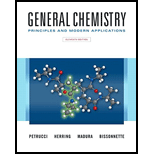
Concept explainers
Interpretation:
The mechanism for the conversion of
Concept introduction:
The preparation of
The
The
A nucleophile is the Lewis base that donates a pair of an electron to form a covalent bond with the electrophile. An electrophile is the Lewis acid that accepts the electron to form a bond with the nucleophile.
The good leaving groups are the weak base. They can be an anion or neutral molecule.
Want to see the full answer?
Check out a sample textbook solution
Chapter 27 Solutions
Generl Chem Looself&mod Mst/et&stdy Crd Pkg, 11/e
- It is typically very difficult to do a substitution reaction on an aromatic ring when the leaving group is flanked by two other bulky substituents. Moreover, in Section 22.3, we found that nucleophilic aromatic substitution requires strongly electron-withdrawing groups on the benzene ring. However, Pd-catalyzed coupling allows entry into such products. As examples, write the products of the following reactions and state which coupling reaction is being utilized.arrow_forwardThe reaction of a phosphonium ylide with a ketone or aldehyde produces an alkene, but, as shown in Problem 17.57, the reaction of a sulfonium ylide produces an epoxide. Explain why. Hint: What is the major driving force for the Wittig reaction to produce an alkene? The S-O bond energy in dimethyl sulfoxide is 362 kJ/mol.arrow_forwardBromine reacts with alkenes in methanol according to the equation: - When this reaction was carried out with 4-tert-butylcyclohexene, only one isomer was formed with the molecular formula C12H23BrO (80% yield). Which of the following is the structure more reasonable for this compound?. Explain your reasoning through acorresponding mechanism.arrow_forward
- 22- Give one example for the hydration of Alkene: That is the Addition of H2O byoxymercuration. Give the proper Mechanism if possible.23- Give one example for the hydration of Alkenes: that is: the addition of H2O byHydroboration.arrow_forwardGive the substitution and elimination products for the following reactions, showing the configuration of each product. It develops all the steps of the reaction mechanisms.arrow_forwardIn SN2 reactions of haloalkanes, the order of reactivity is RI>RBr>RCl>RF. Alkyl iodides are considerably more reactive than alkyl fluorides, often by factors as great as 106. All 1-halo-2,4-dinitrobenzenes, however, react at approximately the same rate in nucleophilic aromatic substitutions. Account for this difference in relative reactivities.arrow_forward
- A chemist allows some pure (2S,3R)-3-bromo-2,3-diphenylpentane to react with a solution of sodium ethoxide(NaOCH2CH3) in ethanol. The products are two alkenes: A (cis-trans mixture) and B, a single pure isomer. Under thesame conditions, the reaction of (2S,3S)-3-bromo-2,3-diphenylpentane gives two alkenes, A (cis-trans mixture) and C.Upon catalytic hydrogenation, all three of these alkenes (A, B, and C) give 2,3-diphenylpentane. Determine the structuresof A, B, and C; give equations for their formation; and explain the stereospecificity of these reactionsarrow_forwardIf phenoxide ion is allowed to react with 1-bromopentane, pentyl phenyl ether is obtained. However, if cyclohexane is used as the alkyl halide, the major products are phenol and cyclohexene. Explain how these products were formed.arrow_forwardPredict the major products formed when 2- methyl-1-butene reacts with: H2O, H+. Show the reaction mechanism of the given alkene reactionsarrow_forward
 Organic ChemistryChemistryISBN:9781305580350Author:William H. Brown, Brent L. Iverson, Eric Anslyn, Christopher S. FootePublisher:Cengage Learning
Organic ChemistryChemistryISBN:9781305580350Author:William H. Brown, Brent L. Iverson, Eric Anslyn, Christopher S. FootePublisher:Cengage Learning



